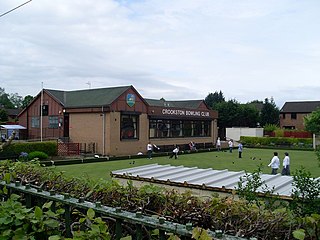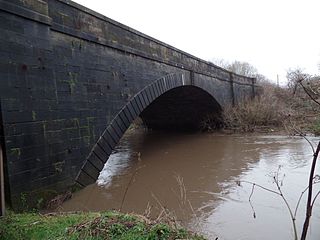
Renfrewshire is one of the 32 council areas of Scotland.

Inchinnan is a small village in Renfrewshire, Scotland. The village is located on the main A8 road between Renfrew and Greenock, just south east of the town of Erskine.

A moveable bridge, or movable bridge, is a bridge that moves to allow passage for boats or barges. In American English, the term is synonymous with drawbridge, and the latter is the common term, but drawbridge can be limited to the narrower, historical definition used in some other forms of English, in which drawbridge refers to only a specific type of moveable bridge often found in castles.

Crookston is a residential suburb on the southwestern edge of the city of Glasgow, Scotland.

The River Cart is a tributary of the River Clyde, Scotland, which it joins from the west roughly midway between the towns of Erskine and Renfrew and opposite the town of Clydebank.

India of Inchinnan is now a commercial site in Inchinnan, Renfrewshire, Scotland, that was formerly used for various industrial uses. It includes the former office block of India Tyres of Inchinnan - a Category A listed building in the art deco style, designed in 1930 by Thomas Wallis of Wallis, Gilbert and Partners. The office block was similar in style to Wallis, Gilbert and Partners' Hoover Building in Perivale, London.

Renfrewshire or the County of Renfrew is a historic county, registration county and lieutenancy area in the west central Lowlands of Scotland. It contains the local government council areas of Inverclyde, Renfrewshire and East Renfrewshire, as well as parts of Glasgow and is occasionally named Greater Renfrewshire to distinguish the county from the modern council area.

Strathgryffe or Gryffe Valley is a strath centred on the River Gryffe in the west central Lowlands of Scotland. The River Gryffe passes through the council areas of Inverclyde and Renfrewshire, rising in Kilmacolm and joining the Black Cart Water between Houston and Inchinnan.

The Corporation Bridge is a Scherzer rolling lift bascule bridge over the Old Dock in Grimsby, North East Lincolnshire, England. Built in 1925, it replaced an earlier swing bridge dating to 1872.

The Levern Water, is a small river in East Renfrewshire and Glasgow, Scotland. It rises in the Long Loch, and flows generally north and east, past the towns of Neilston and Barrhead, for a total distance of 9 miles (14 km). It empties into the White Cart River.

Sir William Arrol & Co. was a leading Scottish civil engineering and construction business founded by William Arrol and based in Glasgow. It built some of the most famous bridges in the United Kingdom including the second Tay Bridge, the Forth Bridge and Tower Bridge in London.

Keadby Bridge, more formally known as the King George V Bridge, crosses the River Trent near Althorpe and Keadby in Lincolnshire, England. It was designed by Alfred Charles Gardner FRSE MIME.

Renfrew is a town 6 miles (10 km) west of Glasgow in the west central Lowlands of Scotland. It is the historic county town of Renfrewshire. Called the "Cradle of the Royal Stewarts" for its early link with Scotland's former royal house, Renfrew gained royal burgh status in 1397.

The River Cart Aqueduct, sometimes known as the Blackhall Bridge, is a railway bridge and former navigable aqueduct in Paisley, Renfrewshire, Scotland. It opened in 1811 as an aqueduct to carry the Glasgow, Paisley and Johnstone Canal over the White Cart Water. Following the closure of the canal in 1881, it was converted to a railway bridge in 1885, and now carries the Paisley Canal Line. It is registered as a Category A listed building by Historic Environment Scotland.

The New River Clyde bridge is a proposed construction as part of the ongoing regeneration of the River Clyde waterfront area, in Scotland. If built, it will be the first new vehicle crossing point on the Clyde since the Clyde Arc bridge was built in 2006.

The disused Park Quay or Fulton's Quay is located on the old Lands of Park, situated on the south bank of the River Clyde in the Parish of Inchinnan, close to Newshot Island and the old Rashielee Quay. A slipway is also part of the infrastructure, giving access to the dock at low tide, both once served by roads running through the Park Estate from the south. It was recorded as Fulton's Quay in 1830, the name of a previous owner of the Park Estate who may have built it prior to 1801. A fixed light was installed at Park Quay in 1869.

The old Rashielee Quay or Rashielie Quay (NS471709) was located on the old Lands of North Barr, situated on the south bank of the River Clyde in the Parish of Inchinnan, between Bodinbo Island and Park Quay. It was built to facilitate the loading of boats and barges with whinstone excavated from the nearby Rashielee Quarries that was brought to the quay by a horse drawn wagonway.

Newshot Island or Newshot Isle was an island of circa 50 acres or 20 hectares lying in the estuarine waters of the River Clyde close to Park Quay in the Parish of Inchinnan, Renfrewshire, Scotland. Due to silting, etc. it has become part of the southern, Renfrewshire side, of the river bank and is used for grazing cattle and as a nature reserve.























